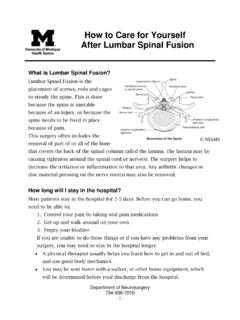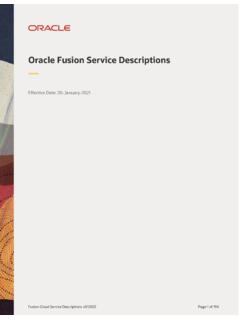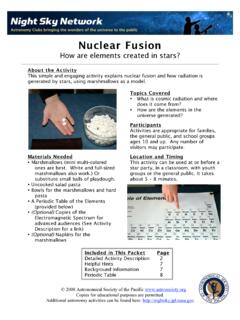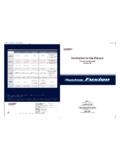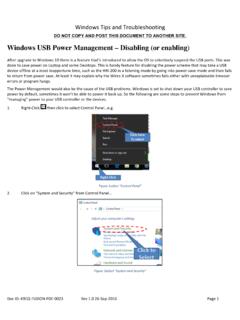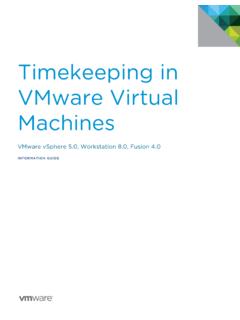Transcription of Dynamic Fusion - University of Washington
1 DynamicFusion: Reconstruction and Tracking of Non-rigid Scenes in Real-TimeRichard A. of Washington , SeattleSteven M. 1:Real-time reconstructions of a moving scene with DynamicFusion; both the person and the camera are moving. The initiallynoisy and incomplete model is progressively denoised and completed over time (left to right).AbstractWe present the first dense SLAM system capable of re-constructing non-rigidly deforming scenes in real-time, byfusing together RGBD scans captured from commodity sen-sors.
2 Our DynamicFusion approach reconstructs scene ge-ometry whilst simultaneously estimating a dense volumet-ric 6D motion field that warps the estimated geometry intoa live frame. Like KinectFusion, our system produces in-creasingly denoised, detailed, and complete reconstructionsas more measurements are fused, and displays the updatedmodel in real time. Because we do not require a templateor other prior scene model, the approach is applicable to awide range of moving objects and scanning traditionally involves separate capture andoff-line processing phases, requiring very careful planningof the capture to make sure that every surface is cov-ered.
3 In practice, it s very difficult to avoid holes, requir-ing several iterations of capture, reconstruction, identifyingholes, and recapturing missing regions to ensure a completemodel. Real-time 3D reconstruction systems like KinectFu-sion [18, 10] represent a major advance, by providing usersthe ability to instantly see the reconstruction and identifyregions that remain to be scanned. KinectFusion spurred aflurry of follow up research aimed at robustifying the track-ing [9, 32] and expanding its spatial mapping capabilities tolarger environments [22, 19, 34, 31, 9].
4 However, as with all traditional SLAM and dense re-construction systems, the most basic assumption behindKinectFusion is that the observed scene is core question we tackle in this paper is:How can wegeneralise KinectFusion to reconstruct and track Dynamic ,non-rigid scenes in real-time?To that end, we introduceDynamicFusion, an approach based on solving for a vol-umetric flow field that transforms the state of the scene ateach time instant into a fixed, canonical frame. In the caseof a moving person, for example, this transformation un-does the person s motion, warping each body configurationinto the pose of the first frame.
5 Following these warps, thescene is effectively rigid, and standard KinectFusion up-dates can be used to obtain a high quality, denoised recon-struction. This progressively denoised reconstruction canthen be transformed back into the live frame using the in-verse map; each point in the canonical frame is transformedto its location in the live frame (see Figure 1).Defining a canonical rigid space for a dynamicallymoving scene is not straightforward. A key contributionof our work is an approach for non-rigid transformation andfusion that retains the optimality properties of volumetricscan Fusion [5], developed originally for rigid scenes.
6 Themain insight is that undoing the scene motion to enable fu-sion of all observations into a singlefixedframe can beachieved efficiently by computing the inverse map this transformation, each canonical point projectsalong a line of sight in the live camera frame. Since theoptimality arguments of [5] (developed for rigid scenes) de-pend only on lines of sight, we can generalize their optimal-ity results to the non-rigid second key contribution is to represent this volumet-ric warp efficiently, and compute it in real time.
7 Indeed,even a relatively low resolution,2563deformation volumewould require 100 million transformation variables to becomputed at frame-rate. Our solution depends on a com-bination of adaptive, sparse, hierarchical volumetric basisfunctions, and innovative algorithmic work to ensure a real-time solution on commodity hardware. As a result, Dynam-icFusion is the first system capable of real-time dense recon-struction in Dynamic scenes using a single depth remainder of this paper is structured as follows.
8 Af-ter discussing related work, we present an overview of Dy-namicFusion in Section 2 and provide technical details inSection 3. We provide experimental results in Section 4 andconclude in Section Related WorkWhile no prior work achieves real-time, template-free,non-rigid reconstruction, there are two categories of closelyrelated work: 1) real-time non-rigidtrackingalgorithms,and 2)offlinedynamic reconstruction non-rigid template vast ma-jority of non-rigid tracking research focuses on human bodyparts, for which specialised shape and motion templates arelearnt or manually designed.
9 The best of these demonstratehigh accuracy, real-time performance capture for trackingfaces [16, 3], hands [21, 20], complete bodies [27], or gen-eral articulated objects [23, 33].Other techniques directly track and deform more gen-eral mesh models. [12] demonstrated the ability to tracka statically acquired low resolution shape template and up-grade its appearance with high frequency geometric detailsnot present in the original model. Recently, [37] demon-strated an impressive real-time version of a similar tech-nique, using GPU accelerated optimisations.
10 In that sys-tem, a dense surface model of the subject is captured whileremaining static, yielding a template for use in their real-time tracking pipeline. This separation into template gen-eration and tracking limits the system to objects and scenesthat are completely static during the geometric reconstruc-tion phase, precluding reconstruction of things that won treliably hold still ( , children or pets).Offline simultaneous tracking and reconstruction ofdynamic is a growing literature onofflinenon-rigid tracking and reconstruction techniques.

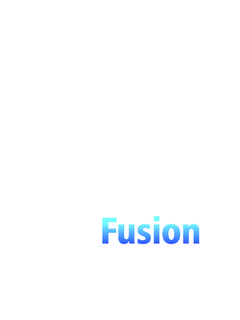
![Untitled-2 [www.columbia.edu]](/cache/preview/3/d/6/3/d/0/d/0/thumb-3d63d0d0343f66e2d86c238c9f8a44b3.jpg)
